Biography of King David I of Scotland 1084-1153
On 16 Mar 1058 Lulach King Scotland died. [his father] Malcolm III King Scotland (age 26) succeeded III King Scotland.
Before 1060 [his father] Malcolm III King Scotland (age 28) and Ingibiorg Finnsdottir Queen Consort Scotland were married. She by marriage Queen Consort Scotland. He the son of Duncan "The Sick" I King Scotland and Bethóc Unknown Queen Consort Scotland.
Flowers of History. Before 25 Dec 1066. [his mother] Queen Margaret (age 21) had six sons and two daughters, three of whom, namely, [his brother] Edgar, [his brother] Alexander, and David, became kings, as they were entitled to by the nobility of their family, and through them the noble blood of the kings of England, who were expelled from their own proper territories by the Normans, devolved upon the kings of Scotland.
Before 1070 [his father] Malcolm III King Scotland (age 38) and [his mother] Margaret Wessex Queen Consort Scotland (age 24) were married. She by marriage Queen Consort Scotland. He the son of Duncan "The Sick" I King Scotland and Bethóc Unknown Queen Consort Scotland.
On 31 May 1076 Waltheof Northumbria 1st Earl of Northampton 1st Earl Huntingdon was beheaded at St Gile's Hill, Winchester. His daughter [his future wife] Maud Queen Consort Scotland (age 2) succeeded 2nd Countess Huntingdon, 2nd Countess of Northampton.
Around 1084 King David I of Scotland was born to Malcolm III King Scotland (age 52) and Margaret Wessex Queen Consort Scotland (age 39).
Around 1090 Simon Senlis 1st Earl of Northampton, Earl of Huntingdon and [his future wife] Maud Queen Consort Scotland (age 16) were married. She the daughter of Waltheof Northumbria 1st Earl of Northampton 1st Earl Huntingdon and Judith Flanders Countess Huntingdon.
On 13 Nov 1093 the Battle of Alnwick was fought at Alnwick, Northumberland [Map] between the forces of [his father] Malcolm III King Scotland (age 62) and Robert de Mowbray 1st Earl Northumbria.

Malcolm III King Scotland (age 62) was killed at The Peth Alnwick [Map]. His son [his half-brother] Duncan II King Scotland (age 33) succeeded II King Scotland. He died a year minus day later.
Malcolm's son [his brother] Edward Dunkeld was killed.
Duncan II King Scotland:
Around 1060 he was born to Malcolm III King Scotland and Ingibiorg Finnsdottir Queen Consort Scotland.
On 12 Nov 1094 Duncan II King Scotland died. His uncle Donald "The Fair White" III King Scotland succeeded III King Scotland.
Edward Dunkeld: he was born to Malcolm III King Scotland and Margaret Wessex Queen Consort Scotland. On 16 Nov 1093 Margaret Wessex Queen Consort Scotland died three days after her husband Malcolm III King Scotland and her son Edward Dunkeld were killed at the Battle of Alnwick.
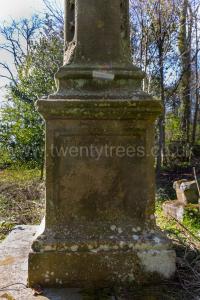
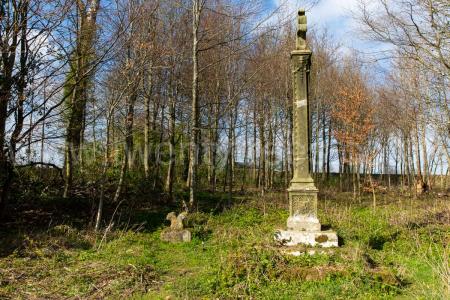
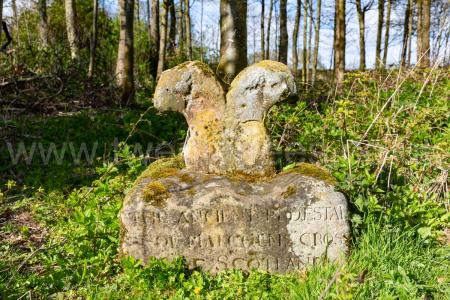
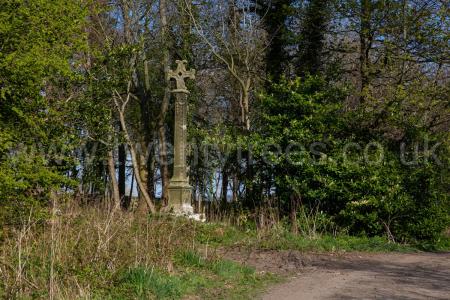
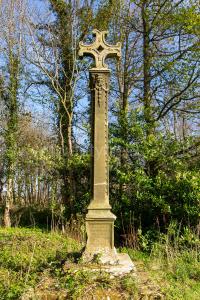
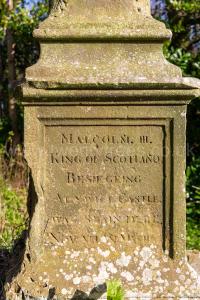
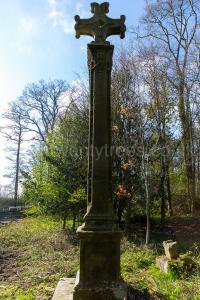
On 16 Nov 1093 [his mother] Margaret Wessex Queen Consort Scotland (age 48) died three days after her husband [his father] Malcolm III King Scotland (deceased) and her son [his brother] Edward Dunkeld were killed at the Battle of Alnwick.
After 1111 King David I of Scotland (age 27) and Maud Queen Consort Scotland (age 37) were married. He by marriage Earl Huntingdon. She the daughter of Waltheof Northumbria 1st Earl of Northampton 1st Earl Huntingdon and Judith Flanders Countess Huntingdon. He the son of Malcolm III King Scotland and Margaret Wessex Queen Consort Scotland.
In 1114 [his son] Henry Dunkeld 3rd Earl Huntingdon 1st Earl of Northumbria was born to King David I of Scotland (age 30) and [his wife] Maud Queen Consort Scotland (age 40).
On 23 Apr 1124 [his brother] Alexander "Fierce" I King Scotland (age 46) died. His brother King David I of Scotland (age 40) succeeded I King Scotland. [his wife] Maud Queen Consort Scotland (age 50) by marriage Queen Consort Scotland.
Anglo-Saxon Chronicle. 1126. In this year the king (age 58) had his brother Robert (age 75) taken from the Bishop Roger of Salisbury, and committed him to his son1 Robert, Earl of Glocester (age 27), and had him led to Bristol, and there put into the castle. That was all done through his daughter's (age 23) counsel, and through David, the king of the Scots (age 42), her uncle.

Note 1. Illegitimate.
Anglo-Saxon Chronicle. After 29 Sep 1126. Then after Michaelmas came David, the king of the Scots (age 42), from Scotland to this land; and the King Henry (age 58) received him with great worship; and he continued all that year in this land.

Anglo-Saxon Chronicle. 1127. This year held the King Henry (age 59) his court at Christmas in Windsor. There was David the king of the Scots (age 43), and all the head men that were in England, learned and lewd. And there he engaged the archbishops, and bishops, and abbots, and earls, and all the thanes that were there, to swear England and Normandy [Map] after his day into the hands of his daughter Athelicia (age 24), who was formerly the wife of the Emperor of Saxony. Afterwards he sent her to Normandy; and with her went her brother Robert, Earl of Glocester (age 28), and Brian, son of the Earl Alan Fergan (age 27);154 and he let her wed the son (age 13) of the Earl of Anjou (age 38), whose name was Geoffry Martel (age 13). All the French and English, however, disapproved of this; but the king (age 59) did it for to have the alliance of the Earl of Anjou (age 38), and for to have help against his nephew William (age 24).


Note 154. See an account of him in "Ord. Vit." 544. Conan, another son of this Alan, Earl of Brittany, married a daughter of Henry I.
16 Apr 1130. The 1130 Battle of Stracathro took place around three miles north of Brechin. The rebellion was led by two pretenders to the Scottish crown, Malcolm Mac Alexander illegitimate son of [his brother] Alexander I of Scotland, and Angus of Moray who was the grandson of King Lulach who had been deposed and killed by David (age 46) taking advantage of King David I of Scotland (age 46) being in England.
In 1131 [his wife] Maud Queen Consort Scotland (age 57) died. Her son [his son] Henry Dunkeld 3rd Earl Huntingdon 1st Earl of Northumbria (age 17) succeeded 3rd Earl Huntingdon, 3rd Earl of Northampton. [his future daughter-in-law] Ada Warenne Countess Huntingdon and Northumbria (age 11) by marriage Countess Huntingdon.

Anglo-Saxon Chronicle. 1135. In this year went the King Henry (age 67) over sea at the Lammas; and the next day, as he lay asleep on ship, the day darkened over all lands, and the sun was all as it were a three night old moon, and the stars about him at midday. Men were very much astonished and terrified, and said that a great event should come hereafter. So it did; for that same year was the king (age 67) dead, the next day after St. Andrew's mass-day, in Normandy. Then was there soon tribulation in the land; for every man that might, soon robbed another. Then his sons and his friends took his body, and brought it to England, and buried it at Reading. A good man he was; and there was great dread of him. No man durst do wrong with another in his time. Peace he made for man and beast. Whoso bare his burthen of gold and silver, durst no man say ought to him but good. Meanwhile was his nephew come to England, Stephen de Blois (age 41). He came to London, and the people of London received him, and sent after the Archbishop William Curboil, and hallowed him to king (age 41) on midwinter day. In this king's (age 41) time was all dissention, and evil, and rapine; for against him rose soon the rich men who were traitors; and first of all Baldwin de Redvers, who held Exeter, Devon [Map] against him. But the king (age 41) beset it; and afterwards Baldwin accorded. Then took the others, and held their castles against him; and David, King of Scotland (age 51), took to Wessington against him. Nevertheless their messengers passed between them; and they came together, and were settled, but it availed little.



In or before 1138 [his former step-son] Simon Senlis 4th Earl Huntingdon 4th Earl of Northampton (age 40) and Isabel Beaumont Countess Huntingdon and Northampton were married. She by marriage Countess Huntingdon, Countess of Northampton. She the daughter of Robert Beaumont 2nd Earl of Leicester (age 33) and Amice Gael Countess Leicester. He the son of Simon Senlis 1st Earl of Northampton, Earl of Huntingdon and Maud Queen Consort Scotland.
Flowers of History 1138. 22 Aug 1138. Of the pitched battle between the Scots and English.
The Scots hearing the shout, like women, raised their usual war-cry of Alban! Alban! which was, however, soon drowned in the dreadful rush of the engaging armies. A body of the men of Lothian, who had obtained from the king (age 54) the honour of striking the first blow, with numbers of missiles and with their long lances, bore down impetuously upon the mailed English knights, but fell upon them like as upon a wall, for they remained immovable. The English archers, then mingling with the cavalry, poured their arrows like a cloud upon the Scots, pierced all who were not protected by their armour, whilst the whole English line and the glory of the Normans, crowding around the standard, remained firm and unshaken. The commander of the men of Lothian fell slain by an arrow, and his men all took to flight. For the most high God was offended with them: therefore their valour was broken like a spider's web in the battle. The main body of the Scots, which was fighting in another part of the field, seeing their comrades routed, lost courage and retreated also. But the king's troops, who were of different clans, began first to flinch individually, and afterwards to recoil in a body, though the king (age 54) still stood firm: but his friends compelled him to mount his horse and fly, whilst his brave [his son] son (age 24), heeding not the flight of the rest, but solely bent on acquirincr glory, charged the lines of the enemy with headlong valour, though his men could do no execution on knights that were sheathed in mail; but at last they were forced to take flight, not, without much bloodshed, and were ignominiously driven off the field in all directions. It was reported that eleven thousand of the Scots were slain, besides those who were found mortally wounded in the corn-fields and woods: our army happily triumphed with very little loss of life, and all the knights, the brother of Gilbert de Lacy was the only one slain. This battle was fought in the month of August, by the people who lived in the country beyond the Humber. The same year, in the month of October, the count of Anjou compelled the inhabitants of Orismes to surrender, and laid siege to Bayeux and Falaise. 

Florence of Worcester Continuation. 22 Aug 1138. Irruption of the Scots, and Battle of the Standard.
During these events, David (age 54), king of Scotland, made a third irruption from the borders of his kingdom, with large bands both of horse and foot, and began to set on fire farms, towns, and castles, on the confines of Northumbria, and lay waste nearly all the country. But as he threatened at last to pursue his inroad as far as York and the Humber, Ralph, archbishop of Canterbury, archbishop of York, had a conference with the Yorkshiremen, and prevailed on them all, with one consent, to take the oath of fealty to king Stephen, and resist the king of Scots. David, however, was still more incensed at this, and rejecting all advice to the contrary, and reaching the river Tees on the octave of the Assumption of St. Mary [22nd August], which happened on a Monday, he determined to surprise our troops, there being a thick fog in the morning of that day. Hoping, in consequence, to come upon us unawares, he left many vills untouched, and would not suffer his men to set fire to any place, as they usually did. Meanwhile, our troops being warned by a squire, though somewhat late so that they were nearly taken by surprise, armed themselves, and drew up in order of battle with the utmost despatch, sending out archers in front, by whom the Scots were severely galled. Then the king's barons marched with the knights, having all dismounted and stationed themselves in the first rank, and thus fought hand-in-hand with the enemy. The conflict was ended, and victory secured at the very first onset, for the Scots gave way, and either fell or fled in the greatest alarm. Our men, however, being on foot, and having caused all their horses to be led to some distance, were unable to continue the pursuit long, otherwise they would have taken or put to the sword the king (age 54) himself, with his [his son] son (age 24), and all his immediate attendants. Of his army, nearly ten thousand men fell in different places, and as many as fifty persons of rank were made prisoners. The vanquished king (age 54) himself escaped by flight, overwhelmed with terror and shame. His chancellor, William Comyn, was taken by the bishop of Durham; but being set at liberty, he gave thanks to God, heartily hoping he should never again fall into such a scrape. The king's son (age 24) reached Carlisle on foot, attended by a single knight; and his father (age 54) escaped with some difficulty through the woods and thickets to Roxburgh. He had led an innumerable army consisting of French, as well as English, Scots, Galwegians, and the people of all the isles which owed him allegiance, but nineteen only out of two hundred of his mailed knights carried back their armour; for every one left nearly all that he had to become the spoil of the enemy, so that an immense booty, both of horses, arms, and clothing, and many other things, was taken from his army. Eustace Fitz-John (age 50), who had joined his expedition, met with a similar fate, having been wounded, and barely escaping with life to his castle. Among the valiant men who, in Christ's name, fought on behalf of king Stephen, were the earl of Albemarle (age 37), Bernard de Baliol, and many others, but the earl was distinguished for his bravery in the battle.1


Note 1. A more detailed account of this famous "Battle of the Standard" will be found in Henry of Huntingdon's History, pp. 267, &c. [.Antiq. Lib.], and in Roger of Wendover, ibid, p. 489. Cf. also William of Newbury, Trivet, and Rieval "de Bello Standardi," in Twysden
Anglo-Saxon Chronicle. 22 Aug 1138. In this year came David, King of Scotland (age 54), with an immense army to this land. He was ambitious to win this land; but against him came William, Earl of Albemarle (age 37), to whom the king (age 44) had committed York, and other borderers, with few men, and fought against them, and routed the king (age 54) at the Standard, and slew very many of his gang.

On 22 Aug 1138 an English army commanded by William "Fat" Blois 1st Earl Albemarle aka Aumale 1st Earl York (age 37), William "The Younger" Peverell (age 58) and Robert III Stuteville defeated a Scottish army led by King David I of Scotland (age 54) and his son [his son] Henry Dunkeld 3rd Earl Huntingdon 1st Earl of Northumbria (age 24). The battle was fought at Cowton Moor, Northallerton. The name "Battle of the Standard is derived from the Standards (banners) of the Bishops of Durham, York, Beverly and Ripon which were flown from a mast mounted on a cart.

Robert III Stuteville: he was born to Robert Stuteville at Estouteville. Before 1186 Robert III Stuteville and Helewise de Murdac were married. In 1186 Robert III Stuteville died. Before 1186 Robert III Stuteville and Sibilla Valognes were married.
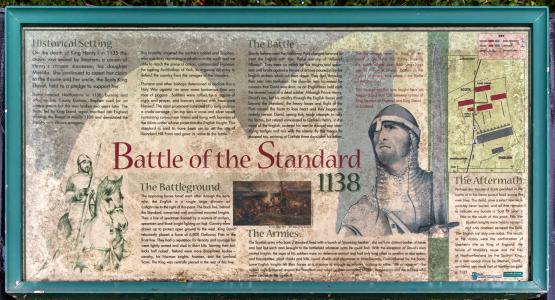
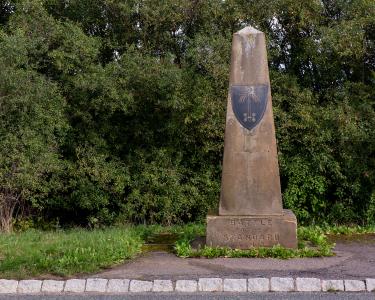
The Chronicle of Henry of Huntingdon Book 8. 22 Aug 1138. While the king was thus engaged in the south, David of Scotland (age 54) led an immense army into the north of England, against which the northern nobles, at the exhortation and under the command of Thurstan, archbishop of York (age 68), made a resolute stand. The royal standard was planted at Alverton1, and as the archbishop was prevented by illness from being present at the battle, he commissioned Balph, bishop of Durham2, to fill his place, who, standing on an eminence in the centre of the army, roused their courage with words to this effect:
Brave nobles of England, Normans by birth ; for it is well that on the eve of battle you should call to mind who you are, and from whom you are sprung: no one ever withstood you with success. Gallant France fell beneath your arms; fertile England you subdued; rich Apulia flourished again under your auspices; Jerusalem, renowned in story, and the noble Antioch, both submitted to you. Now, however, Scotland which was your own rightly, has tataken you at disadvantage, her rashness more fitting a skirmish than a battle. Her people have neither military skill, nor order in fighting, nor self command. There is, therefore, no reason for fear, whatever there may be for indignation, at finding those whom we have hitherto sought and conquered in their own country, madly reversing the order, making an irruption into ours. But that which I, a bishop, and by divine permission, standing here as the representative of our archbishop, tell you, is this: that those who in this land have violated the temples of the Lord, polluted his altars, slain his priests, and spared neither children nor women with child, shall on this same soil receive condign punishment for their crimes. This most just fulfilment of his will God shall this day accomphsh by our hands. Rouse yourselves, then, gallant soldiers, and bear down on an accrursed enemy with the courage of your race, and in the presence of God. Let not their impetuosity shake you, since the many tokens of our valour do not deter them. They do not cover themselves with armour3 in war; you are in the constant practice of arms in times of peace, that you may be at no loss in the chances of the day of battle. Your head is covered with the helmet, your breast with a coat of mail, your legs with greaves, and your whole body with the shield. Where can file enemy strike you when he finds you sheathed in steel? "What have we to fear in attacking the naked, bodies of men who know not the use of armour? Is it their numbers? It is not so much the multitude of a host, as the valour of a few, which is decisive. Numbers, without discipline, are an hindrance to success in the attack, and to retreat in defeat. Your4 ancestors were often victorious when they were but a few against many. What, then, does the renown of your fathers, your practice of arms, your military discipline avail, unless they make you, few though you are in numbers, invincible against the enemy's hosts? But I close my discourse, as I perceive them rushing on, and I am delighted to see that they are advancing in disorder. Now, then, if any of you who this day are called to avenge the atrocities committed in the houses of God, against the priests of the Lord, and his little flock, should fall in the battle, I, in the name of your archbishop, absolve them from all spot of sin, in the name of the Father, whose creatures the foe hath foully and horribly slain, and of the Son, whose altars they have defiled, and of the Holy Ghost, from whose grace they have desperately fallen."
Note 1. Allerton. This famous Battle of the Standard is also fully described by Roger of Wendover. See also William of Newbury and Trivet; but the MS. of the "Gesta Stepfani" after relating the irruption into Northumberland, becomes imperfect just in this place.
Note 2. Both the MSS. which I have consulted concur with Savile's printed text in the reading of "Orcadum;" but as Roger of Wendorer calls Ralph Bishop of Durham, and he was evidently a suffragan of the Archbishop of York, I have adopted that reading. Perhaps the bishop of Durham had jurisdiction in the Orkneys? [Note. Possibly Bishop Radulf Novell, Bishop of Orkney?]
Note 3. "Nesciunt annare se ;" and just afterwards the historian calls them "nudos et inermes!" Not that they went to battle unarmed, as the passage has been rendered, but the rank and file of the Scots used no defensive armour, and perhaps, like their posterity, they only wore the kilt.
Note 4. Arundel MS., "our."
Before 1139 [his son] Henry Dunkeld 3rd Earl Huntingdon 1st Earl of Northumbria (age 25) and [his daughter-in-law] Ada Warenne Countess Huntingdon and Northumbria (age 18) were married. She the daughter of William Warenne 2nd Earl Surrey and Elizabeth Capet Countess Leicester, Meulan and Surrey. He the son of King David I of Scotland (age 54) and Maud Queen Consort Scotland.


On 12 Jun 1152 [his son] Henry Dunkeld 3rd Earl Huntingdon 1st Earl of Northumbria (age 38) died. His half brother [his former step-son] Simon Senlis 4th Earl Huntingdon 4th Earl of Northampton (age 54) succeeded 4th Earl Huntingdon, 4th Earl of Northampton. His son Malcolm IV King Scotland (age 11) succeeded 2nd Earl of Northumbria, 5th Earl of Northampton.
In 1153 [his former step-son] Simon Senlis 4th Earl Huntingdon 4th Earl of Northampton (age 55) died. His nephew Malcolm IV King Scotland (age 11) succeeded 5th Earl Huntingdon, 5th Earl of Northampton.
On 24 May 1153 King David I of Scotland (age 69) died at Carlisle, Cumberland [Map]. His grandson Malcolm IV King Scotland (age 12) succeeded King Scotland.
Kings Wessex: Great Grand Son of King Edmund "Ironside" I of England
Kings Scotland: Son of Malcolm III King Scotland
Agnes La Marck Queen Consort Navarre x 2
William "Lion" I King Scotland x 1
John "Empty Coat" I King Scotland x 1
Robert "The Bruce" I King Scotland x 2
Philip "Noble" III King Navarre x 1
Joan Évreux Queen Consort France x 1
Margaret Hainault Holy Roman Empress x 1
Philippa of Hainault Queen Consort England x 1
King Robert II of Scotland x 1
Blanche Valois Holy Roman Empress Luxemburg x 1
Blanche Dampierre Queen Consort Norway and Sweden x 1
Joan Auvergne Queen Consort France x 1
Joanna Bourbon Queen Consort France x 2
Blanche Bourbon Queen Consort Castile x 2
Philippa Lancaster Queen Consort Portugal x 1
Yolande of Bar Queen Consort Aragon x 1
Philippa Lancaster Queen Consort Denmark x 1
Joan Beaufort Queen Consort Scotland x 1
Jacquetta of Luxemburg Duchess Bedford x 1
Mary of Guelders Queen Consort Scotland x 2
Charlotte Savoy Queen Consort France x 1
King Richard III of England x 3
Anne Neville Queen Consort England x 8
King Henry VII of England and Ireland x 2
Bianca Maria Sforza Holy Roman Empress x 1
Anne of Brittany Queen Consort France x 1
Philip "Handsome Fair" King Castile x 4
Germaine Foix Queen Consort Aragon x 2
Marguerite Valois Orléans Queen Consort Navarre x 4
Queen Anne Boleyn of England x 7
Anne Jagiellon Holy Roman Empress x 3
Catherine Parr Queen Consort England x 9
Anne of Cleves Queen Consort England x 4
Mary of Guise Queen Consort Scotland x 10
Queen Catherine Howard of England x 8
Jane "Nine Days Queen" Grey I Queen England and Ireland x 14
Louise Lorraine Queen Consort France x 6
King James I of England and Ireland and VI of Scotland x 9
Maximilian "The Great" Wittelsbach I Duke Bavaria I Elector Bavaria x 8
Maria Anna Wittelsbach Holy Roman Empress x 8
Electress Louise Juliana of the Palatine Rhine x 4
Ferdinand of Spain II Holy Roman Emperor x 1
Margaret of Austria Queen Consort Spain x 1
Eleonora Gonzaga Queen Consort Bohemia x 2
Maria Leopoldine Habsburg Spain Queen Consort Bohemia x 1
Marie Françoise Élisabeth of Savoy Queen Consort of Portugal x 14
Victor Amadeus King Sardinia x 16
Maria Anna Neuburg Queen Consort Spain x 4
Joseph I Holy Roman Emperor x 4
Charles Habsburg Spain VI Holy Roman Emperor x 4
Francis I Holy Roman Emperor x 7
Elisabeth Therese Lorraine Queen Consort Sardinia x 7
President George Washington x 4
King George III of Great Britain and Ireland x 4
Caroline Matilda Hanover Queen Consort Denmark and Norway x 4
Caroline of Brunswick Queen Consort England x 4
King Christian I of Norway and VIII of Denmark x 8
Frederick VII King Denmark x 12
Queen Louise Hesse-Kassel of Denmark x 8
Queen Victoria of the United Kingdom x 8
Queen Sophia of Sweden and Norway x 4
Victoria Empress Germany Queen Consort Prussia x 24
King Edward VII of the United Kingdom x 24
Frederick Charles I King Finland x 8
Alexandrine Mecklenburg-Schwerin Queen Consort Denmark x 12
Victoria Eugénie Mountbatten Queen Consort Spain x 24
Louise Mountbatten Queen Consort Sweden x 24
Ingrid Bernadotte Queen Consort Denmark x 24
Philip Mountbatten Duke Edinburgh x 24
Queen Elizabeth II of the United Kingdom x 1187
Carl XVI King Sweden x 48
Queen Consort Camilla Shand x 437
Diana Spencer Princess Wales x 4108
GrandFather: Duncan "The Sick" I King Scotland 
Father: Malcolm III King Scotland 
GrandMother: Bethóc Unknown Queen Consort Scotland
Great x 4 Grandfather: King Edmund I of England
Great x 3 Grandfather: King Edgar "Peaceful" I of England
Great x 4 Grandmother: Aelfgifu of Shaftesbury Queen Consort England
Great x 2 Grandfather: King Æthelred "Unready" II of England
Great x 4 Grandfather: Ordgar Earldorman Devon
Great x 3 Grandmother: Aelfthryth Queen Consort England
Great x 1 Grandfather: King Edmund "Ironside" I of England
Great x 3 Grandfather: Thored Northumbria
Great x 2 Grandmother: Aelfgifu of York Queen Consort England
GrandFather: Edward "The Exile" Wessex
Great x 1 Grandmother: Ealdgyth Unknown
Mother: Margaret Wessex Queen Consort Scotland
GrandMother: Agatha